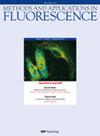角蛋白固有荧光作为一种无创监测其糖化的机制。
IF 2.4
3区 化学
Q3 CHEMISTRY, ANALYTICAL
引用次数: 0
摘要
我们研究了角蛋白固有荧光作为其糖基化指标的演变。在体外PBS溶液中检测游离角蛋白和角蛋白葡萄糖样品的稳态和时间分辨荧光。荧光响应的变化表明,葡萄糖的作用表现在加速形成荧光交联,在460 nm处有发射峰,形成新的交联,在525 nm和575 nm处有发射峰。研究了这些结构的荧光动力学,并讨论了它们在糖尿病长期并发症检测中的潜在应用。本文章由计算机程序翻译,如有差异,请以英文原文为准。
Keratin intrinsic fluorescence as a mechanism for non-invasive monitoring of its glycation.
We have studied the evolution of keratin intrinsic fluorescence as an indicator of its glycation. Steady-state and time-resolved fluorescence of free keratin and keratin-glucose samples were detected in PBS solutionsin vitro. The changes in the fluorescence response demonstrate that the effect of glucose is manifest in the accelerated formation of fluorescent cross-links with an emission peak at 460 nm and formation of new cross-links with emission peaks at 525 nm and 575 nm. The fluorescence kinetics of these structures is studied and their potential application for the detection of long-term complications of diabetes discussed.
求助全文
通过发布文献求助,成功后即可免费获取论文全文。
去求助
来源期刊

Methods and Applications in Fluorescence
CHEMISTRY, ANALYTICALCHEMISTRY, PHYSICAL&n-CHEMISTRY, PHYSICAL
CiteScore
6.20
自引率
3.10%
发文量
60
期刊介绍:
Methods and Applications in Fluorescence focuses on new developments in fluorescence spectroscopy, imaging, microscopy, fluorescent probes, labels and (nano)materials. It will feature both methods and advanced (bio)applications and accepts original research articles, reviews and technical notes.
 求助内容:
求助内容: 应助结果提醒方式:
应助结果提醒方式:


